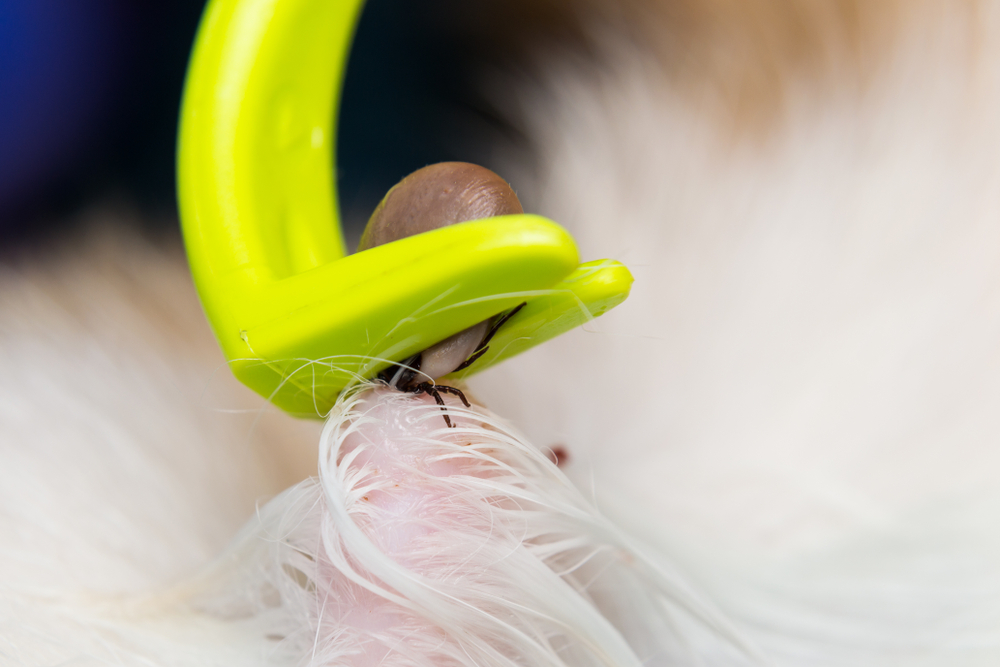Ticks are a growing threat to pet and human health, because their traditional ranges are expanding as weather patterns change. The deer tick, which can carry Lyme disease, is often considered the most dangerous, but any tick can spread a number of diseases. The North Waterloo Veterinary Hospital team wants pet owners to know that tick prevention and prompt removal are key to preventing disease spread. Here is everything pet owners should know about ticks and what they should do if they find one on their pet.
Why are ticks a problem for pets?
A tick’s most serious threat is transmission of tick-borne diseases, including Lyme disease, anaplasmosis, and babesiosis. Ticks can transmit disease after attaching to your pet and feeding for several hours or days, depending on the specific organism. Removing ticks promptly prevents disease spread, but these pests aren’t always easy to spot—a nymph-stage tick is barely big enough to see with the naked eye. A complete tick control program should include prevention and avoidance strategies to prevent bites from happening.
How can I avoid ticks on my pet?
Ticks are active most of the year, whenever temperatures are above 40 degrees Fahrenheit (i.e., 4 degrees Celsius). Avoiding ticks requires vigilance and consistency. Practice these strategies:
- Administer a topical or oral long-lasting flea and tick preventive, as directed by your veterinarian—typically once monthly or every three months, depending on the product. These products kill attached ticks, and some may also repel them.
- Stay on paved or mowed paths during walks and avoid letting pets off-leash in grassy or wooded areas.
- Remove leaf litter, trim shrubs, and trim grass short.
- Check pets for ticks thoroughly each time they have been outside. Pay special attention to between their toes, around eyes and ears, under the collar, and under the arms and legs.
- Ask our team about the Lyme disease vaccine for your dog.
What should I do if I find a tick on my pet?
Immediately remove any ticks you find on your pet to reduce the chances of disease transmission. Tick removal does not require any special strategies—burning or drowning them are old wives’ tales and will not make the process easier. Instead, purchase a tick key or tick twister tool designed to quickly and easily remove a tick, or use the tweezer method:
- Grasp the base of the tick’s head close to your pet’s skin. The head is extremely small and hard to see, but is visible since ticks attach only with their mouthparts and do not embed in the skin. Do not grasp the large, likely engorged body.
- Pull with steady, smooth pressure straight out from your pet’s body, until the tick releases.
- Do not smash the tick, which could expose you to disease. Placing the tick in a container with rubbing alcohol is the best disposal method.
How do I know if a tick is making my pet sick?
Not all pets exposed to a tick-borne disease organism get sick. Several days, weeks, or sometimes months may pass after the tick bite before you see illness signs, which will vary depending on the specific disease, but could include the following:
- Lethargy
- Poor appetite
- Swollen lymph nodes
- Fever
- Limping or joint swelling
- Eye inflammation
- Bleeding or clotting problems
- Kidney or liver problems
Our veterinary team may order specialized tick disease titer tests that look for antibodies to specific organisms, or a PCR test, which looks for genetic material associated with specific organisms, if we suspect your pet’s illness is tick-related. Treatment usually involves long-term antibiotics.
Does my pet need a tick-borne disease screening test?

A different tick-borne disease test, called a 4DX or Accuplex 4, depending on the laboratory, is available to screen healthy pets. This annual test is performed along with your pet’s heartworm test and is often recommended for high-risk pets.
Tick-borne diseases are a constant threat to pets who spend time outdoors when ticks are active. Contact North Waterloo Veterinary Hospital if you need help removing a tick from your pet, to request a tick-removal demonstration, or to schedule a wellness exam and tick-borne disease screening.







Leave A Comment